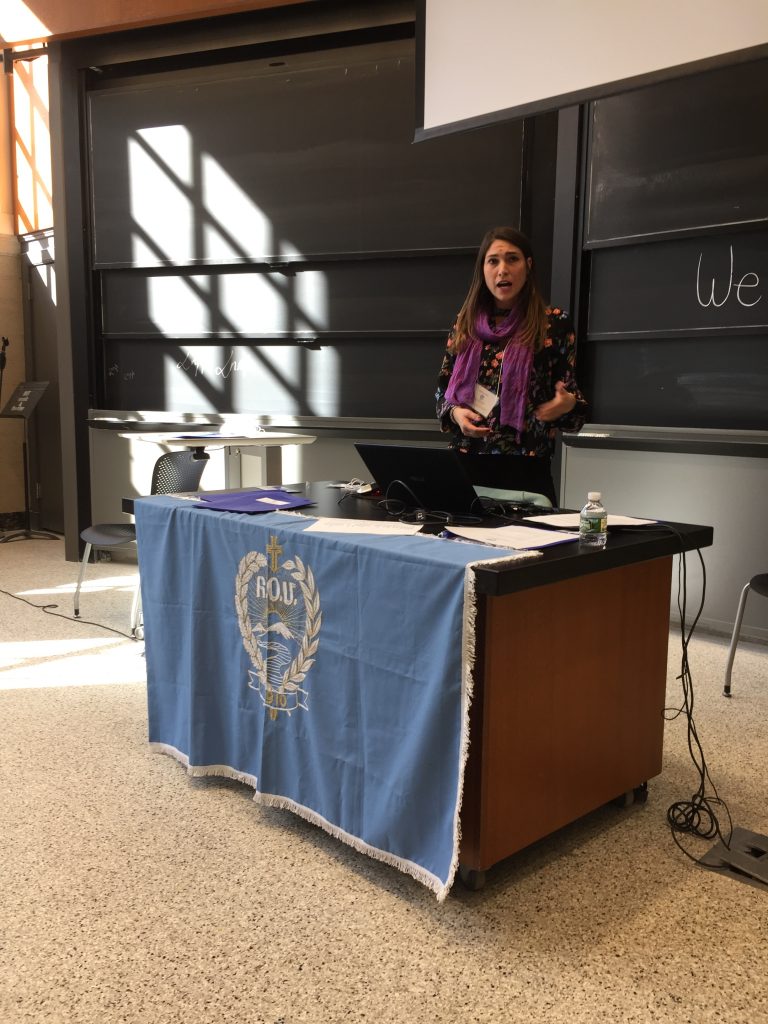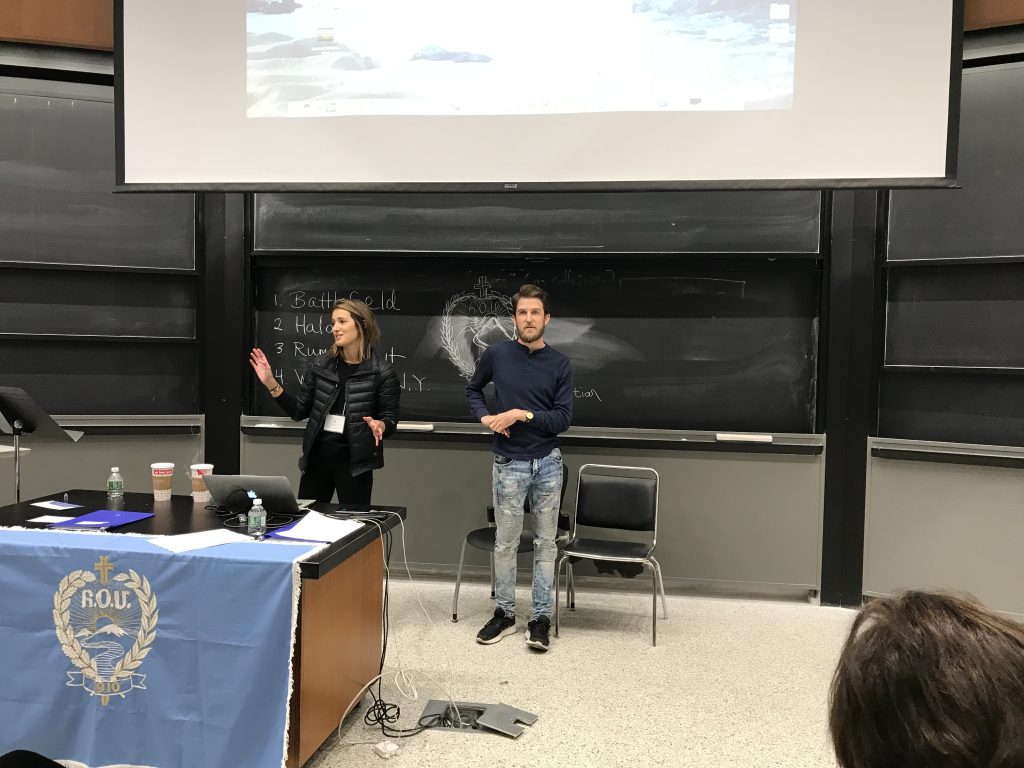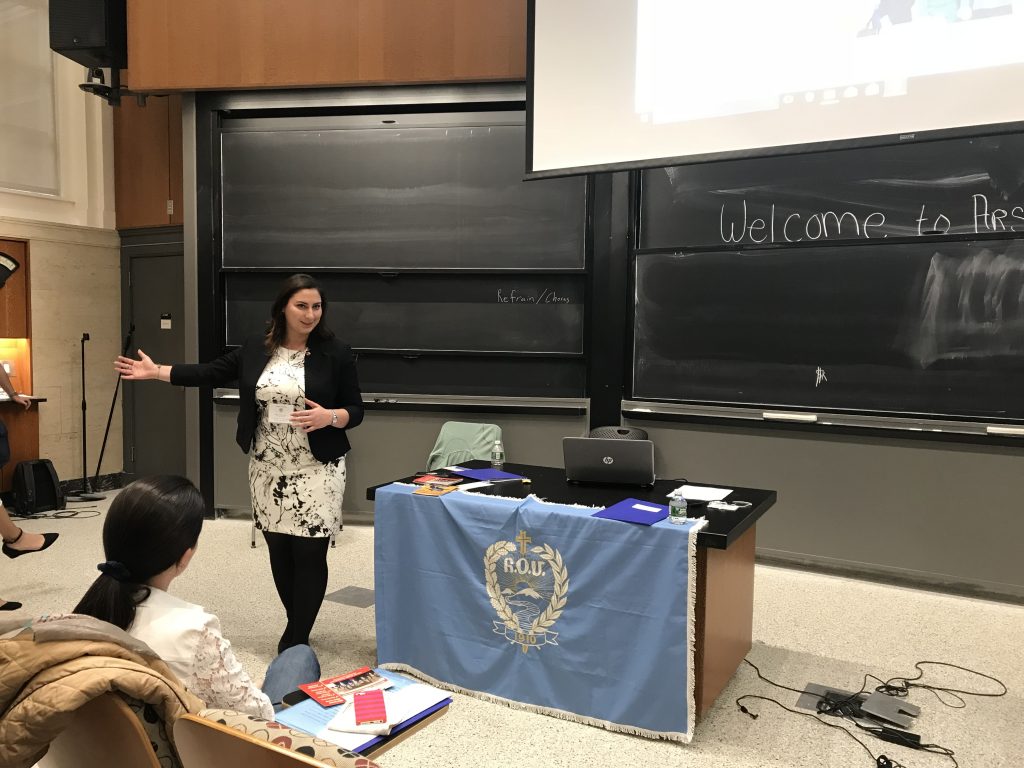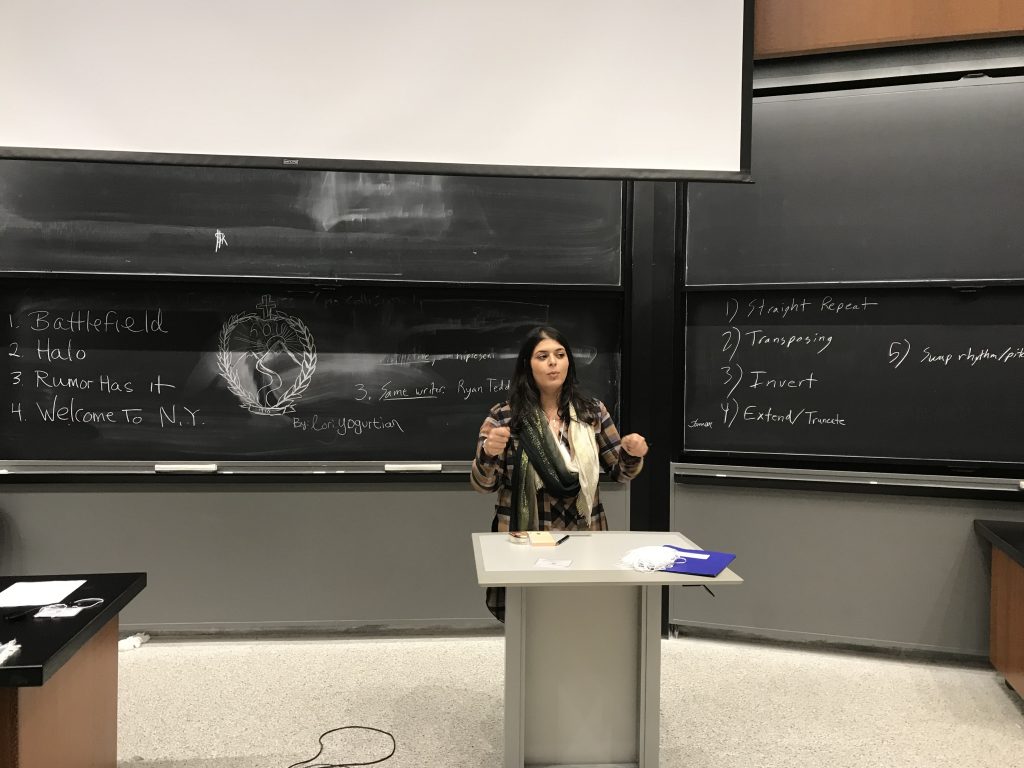Special to the Armenian Weekly
CAMBRIDGE, Mass. (A.W.)—The highly successful Armenian Relief Society (ARS) Norian Youth Connect Program (YCP) convened again on Nov. 4, for a full day of lectures, workshops, and networking. Over 70 college-aged Armenian students from the all over the U.S. and Canada gathered at the Massachusetts Institute of Technology (MIT) to learn about non-conventional approaches to Armenian history, culture, activism, and the arts.

The program was sponsored and organized by the ARS Eastern U.S., with a generous endowment from the Norian Fund, and the MIT Armenian Society. For the fourth year in a row, the director was the Nikit and Eleanora Ordjanian Visiting Professor at Columbia University, Dr. Khatchig Mouradian.
Due to the surging popularity of YCP, which has existed in its current form for nearly the past decade, the organizers decided to hold a second installment of the program last year. To keep up with popular demand, YCP is now held twice annually—in March at Columbia University and in November at MIT.
Each installment of the program embodies a particular theme. This time around, the morning session focused on the historical trajectory of activism and human rights issues—from the Armenian Genocide to the present-day refugee crisis. Speakers were Dr. Mouradian, Asya Darbinyan, and Kathryn Metz. The afternoon session included a workshop led by musicians Tamar Kaprelian and Andrew Fox, and a panel of presenters on various internship and community service opportunities in D.C., Armenia, Georgia, and beyond.
The day’s events commenced with a welcome and brief introduction from the ARS Eastern U.S. chair Talin Daghlian, who praised the students on their intelligence, curiosity, passion, and dedication to Armenian and humanitarian issues, calling them the torchbearers “for the survival and perpetuation of our nation.”
Ungerouhi Daghlian also presented the many charitable initiatives of the ARS Eastern U.S., such as ongoing aid to Syrian refugees, the construction of a kindergarten in Artsakh this fall, and multiple scholarship opportunities for American university students.
The first presentation of the day, given by Dr. Mouradian, transported the audience back to 1915—not the easiest way to start a morning. Against the backdrop of the Armenian Genocide—replete with stories of love, betrayal, and human flaws and resilience—such was the life of Aram Manoukian, the beloved statesman and “first man” of the short-lived First Republic of Armenia (1918-1920).

He is a man we all know superficially but do not really understand. Aram accidentally found himself the leader of the Van Resistance, which—for a few short months in 1915—was the first Armenian-controlled province in 500 years. Through his many trials and tribulations, he learned how to lead his people to hard-won, almost inconceivable, independence. “Aram’s case is an example of leadership being something that is learned, not a birthright,” contended Mouradian. “Leadership is the ability to learn from mistakes, overcome challenges, and make choices to become a leader,” said the professor. “He wasn’t born Aram; he became Aram.”
Another important historical figure for Armenians, intellectuals, and women the world over was Diana Apgar, the world’s first female diplomat in global politics. Apgar played a key role in advocating for the nascent Armenian state and helping Armenian refugees from the Genocide in East Asia—all while running her late husband’s business and raising children—truly a Wonder Woman of the early 20th century.
The lesson here, Mouradian stressed, is that “resistance is a very broad category, and includes all kinds of acts against violence. Even silence can be resistance.”
Continuing on the themes of resistance, wartime conflict, and genocide, the next two presentations tied together a century of refugee crises—beginning with the Armenian Genocide and ending with the current global refugee calamity.
Asya Darbinyan, a PhD candidate in Holocaust and Genocide Studies at Clark University’s Strassler Center, led the first presentation, providing an overview of the Russian humanitarian response to the Armenian Genocide and its subsequent refugee crisis. “Russia and humanitarianism are rarely coupled,” quipped Darbinyan, but the Empire helped Armenian victims and refugees immensely in the aftermath of the genocide, she continued.

To paint a picture of the crisis the Russian Empire was dealing with in the period during and immediately after WWI, Darbinyan explained that there were about 120-150,000 refugees in the Caucasus: “Etchmiadzin became a major refugee town.” The population was about 6,000 in 1916, and blew up with about 30,000 refugees just two years later. Darbinyan concluded her historical presentation with a contemporary and poignant message: “Refugees are always around us. They are in need of compassion, real support, and action.”
The next presenter, Kathryn Metz, is an expert when it comes to showing compassion and taking action for refugees. As the Outreach Coordinator at Ohio State University’s Slavic and East European Center, she gives presentations to K-12 teachers on how to instruct on human rights issues in Eastern Europe. Metz spoke about her experience meeting with Afghan refugees on the borderlands in the EU, presenting a slideshow and quotes from her personal encounters with such individuals—in her case, all young, single Afghan men— who are escaping violence and instability in their country, only to be caught in a more volatile predicament in the Balkan Route to inland Europe.
“All of the individuals I spoke with said they did not want to leave their home countries, but they had no choice. They fear for their safety,” explained Metz. Most of them were former informants or translators for the American military, but could not wait long enough for the U.S. government to process their asylum visas, as many had already been targeted and threatened by the Taliban. Most of these refugees end up relying on smugglers—dangerous and untrustworthy profiteers—to help them reach safety.

During the question answer session, a student asked if the same hostile reactions against refugees today existed in the early 20th century, to which the presenters replied, yes and no. Taking in massive groups of people exiled from their homes and on the cusp of death is not something that any country wants, but the humanitarian framework that was built during WWI set the precedent for the kind of mass-scale institutional and organizational philanthropic efforts we see combatting the current refugee crisis.
After informative lectures on politics and human rights issues, students had the chance to reconvene after the lunch break with a lighter, interactive workshop on music, led by former Eurovision Song Contest participant Tamar Kaprelian and musician Andrew Fox. Kaprelian and Fox have started a nonprofit musical initiative in Armenia, called the Nvak Foundation, which is devoted to discovering, training, supporting, and nurturing young musical talent in Armenia through non-traditional musical education.
The program is the first of its kind to capitalize on the abilities of young budding musicians in Armenia. The foundation hopes “to build a program that is so strong that we can get musicians from all over the world going to Armenia,” said Fox.

Already, Nvak has stepped into a goldmine of musical talent in the country. Fox played a brief audio clip of a young singer. At just 14 years old, Sanahin writes and performs her own indie compositions in English. Kaprelian revealed that she and Capital Cities front man Sebu Simonian are starting their own production company and plan to sign Sanahin as their first artist. “The level of untapped talent with a lot of potential [in Armenia] is insane,” says Kaprelian.
The presenters then led a fun group activity on American music—a sample lesson from the program they teach in Armenia—in which students were asked to parse the similarities of four contemporary pop songs. The result was a boisterous group brainstorming session, filled with laughter and unsolicited singing. Before concluding, Kaprelian unveiled the music video for her cover rendition of the folk classic, “Noubari Boye,” shot in the beautiful mountains of Armenia’s countryside.
The final section of the program included short presentations from five young women, who made their pitch for why students should get involved in their respective organizations.
The first was led by Carnie Armenian, an architect from the West Coast, who discussed her experiences in Georgia, interning at ARS Camp Javakhk, which serves the heavily impoverished Armenian community of Javakhk.

“Javakhk is the only historically Armenian land predominantly inhabited by Armenians, under a foreign republic,” explained Armenian. With aid from the ARS, the Armenian community is able to sustain itself with some level of dignity, maintaining three community centers, schools, and medical facilities with much-needed supplies.
Tania Sahakian discussed the new internship opportunities at the Tumo Center for Creative Technologies, a free of charge digital media learning center for children aged 12-18 in Armenia. The center is one of the best private investments in the Republic of Armenia, providing a new generation with vital skills for a 21st century world in a trendy, convivial environment.
“I’m here to invite you to Armenia and to Tumo,” said Sahakian. The internships are open to any and all college students and professionals, with a focus on the technology and art fields.

Kohar Avakian, a Dartmouth College graduate from Worcester, Mass, visited Armenia for the first time this summer through the AYF internship. Avakian spoke about her experience in Armenia as a diasporan and how vital that was in dispelling the preconceived notions she had of her homeland. “Armenia was a collection of symbols, images, songs, dances, and words.” The experience was different from mere culture shock, as “you have an emotional, historical, and ethical connection to this land—this liminal space,” she explained.

The next presenter was Tereza Yerimyan, the program director of the Hovig Apo Saghdejian Capital Gateway Program (CGP), a unique job placement program of the Armenian National Committee of America (ANCA). The program helps young professionals reach their public policy career goals in Washington, D.C. Yerimyan pitched many of the internship and volunteer opportunities with the ANCA, such as the Leo Sarkisian Summer Internship for current college students and the CGP program for recent graduates looking for a career in our nation’s capital.

Helena Bardakjian of Detroit gave the final presentation of the night, representing both the ARS and the Hamazkayin Armenian Educational and Cultural Society. Bardakjian informed students of the annual Hamazkayin ArtLinks retreat, open to all Armenian youth aged 21-35. This year, the program will convene in Philadelphia from June 28-July 1. She also discussed many of the initiatives sponsored and led by the ARS Eastern Region, which includes the YCP program, and encouraged all students to become members and volunteers of the organization.
Through each installment, YCP never fails to surprise, enlighten, entertain, and present issues and concepts in a fresh and exciting way. It is one of the best forums for youth to juggle their multiple identities—as Armenians, diasporans, students, young professionals, activists, and just curious minds. The speakers are knowledgeable, approachable, and as dynamic as the presentations themselves—and, increasingly, demographically representative of their audience.

All Armenian youth are encouraged to attend, probe, ask questions, share feedback, and utilize what they learned, outside of the lecture halls.
Year after year, participants’ feedback is overwhelmingly positive, proving how this unique platform empowers and inspires the youth to make a change in their individual, communal, and professional lives. Already, the program has built a fan base of returning members—self-professed “cheerleaders of YCP.”
If you are a college student looking to meet interesting people, have fulfilling conversations, and learn about Armenian matters from a novel lens, then make sure you sign up for YCP in New York next spring!
Reflections from YCP MIT 2017
“After participating in ARS’s Youth Connect Program for the third time, I can proudly say that the program only keeps improving. With captivating lectures and creative workshops, Youth Connect strives to provide a healthy environment for dialogue and discussion among the young professionals and college students in attendance.”
—Dickran Khodanian, Boston University alumnus

“Youth Connect is an amazing experience to be a part of. It’s not only an incredible opportunity to learn more about topics relating to our history and culture, but also brings together a community of young Armenians from around North America to strengthen friendships and create new ones.”
—Lori Yogurtian, Suffolk University alumna

“While so much learning happens in the panels, another very important aspect of Youth Connect happens outside the lecture hall. The program lives up to its name and provides an invaluable environment for students to connect with others, within and outside of their respective fields.”
—Samuel Chakmakjian, Brandeis University alumnus
For more information about the Armenian Relief Society Eastern Region, visit http://arseastusa.org/.


This is very beautifully done. The main problem after living and breathing in Armenia is corruption!! That is the first thing that needs to be addressed. I am living proof of that since after moving here I have been battling the corrupt Armenian courts for the entire time frame(10 years now) I have lived in Armenia. There is no control over them and it is really out of control . If nothing is done, I will loss everything which I have brought and invested in Armenia. I will be homeless in Armenia because I believed in my country. I love my country and still do. I have spoken to many important people, in governmental positions and out and they all know this problem exists but nothing is being done about it. The Diaspora Minister, Ms. Hagopyan, told me why I hadn’t gone to her when I first got to Armenia. My answer was that the department did not exist in 2003!! She then said she can not help. If they can not help, then why do they tell us to come home. I have come to live here, raise my family here, start a business, create jobs, and invest in Armenia. All I have seen is corruption everywhere. Nothing is right. Everything is wrong. The whole country is out of order. It is chaos every which way you look at it. Please this country can not survive without a trustworthy justice system. Every problem steams from corruption. This is the only thing the diaspora needs to conquer and address until it is controlled. I don’t know what else to say, but that I am very tired of fighting for my rights in Armenia. I want to get out of these corrupt courts that has sucked me in and will not let me go. I have created 2 companies, work day and night. I want to do more for my country but I can’t anymore. I have lost the care I had when I moved here in 2008. Armenia has broken my heart, has raped me literally of my dignity and my hopes that I can make a change in Armenia. My main objective was to move here to create jobs but all I did was create a huge job for myself. That job was going to court, dealing with court paperwork, dealing with 2 sided lawyers, dealing with bribes, dealing with injustice, dealing with the pain of losing it all. The stop of corruption is the only salvation for Armenia and its future.
Great article. If we were concerned about where tomorrow’s Armenian leadership is, you have shown us great examples. Thank you.